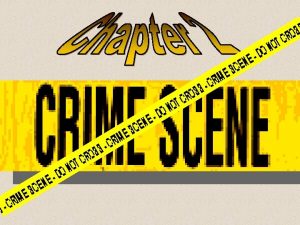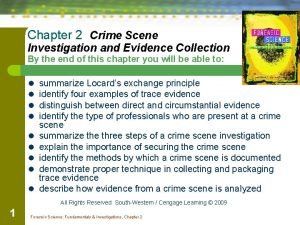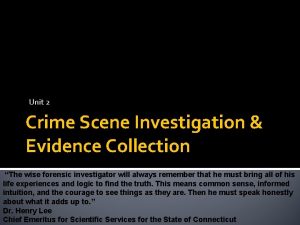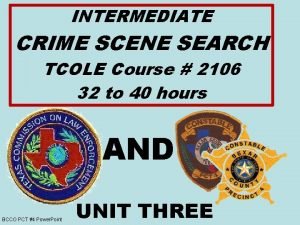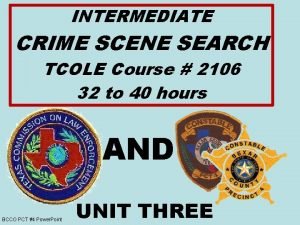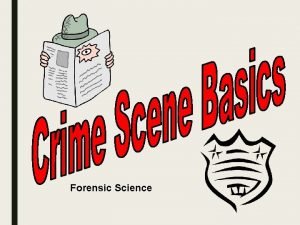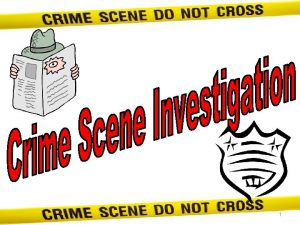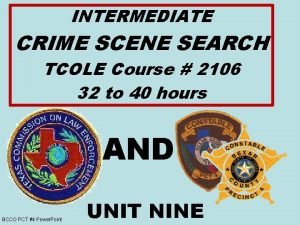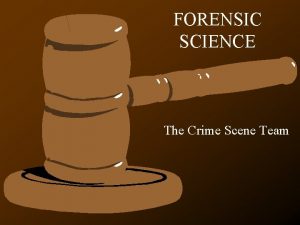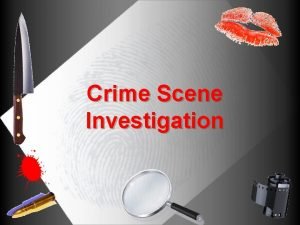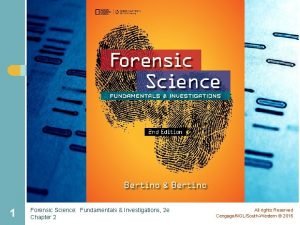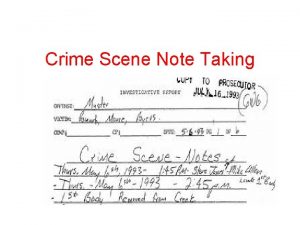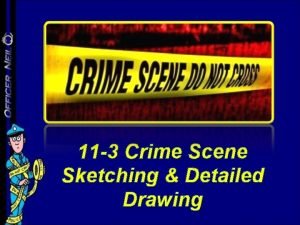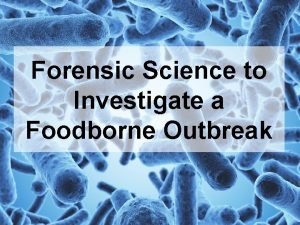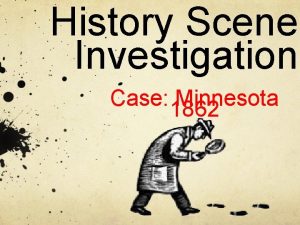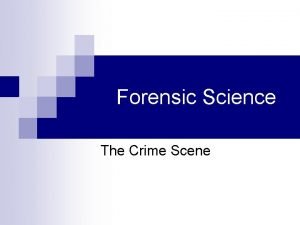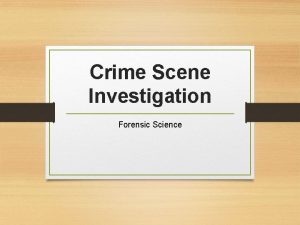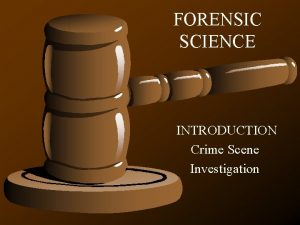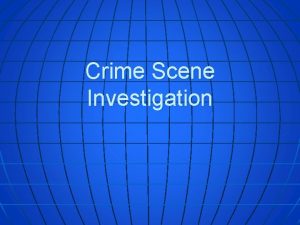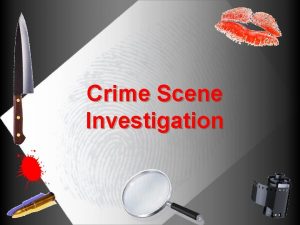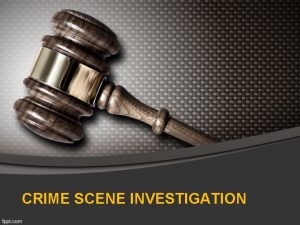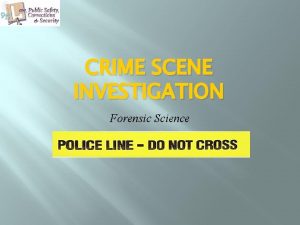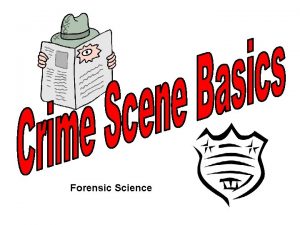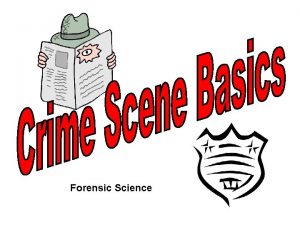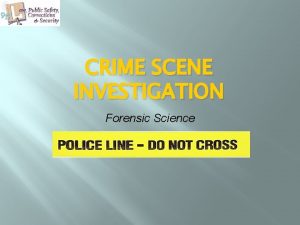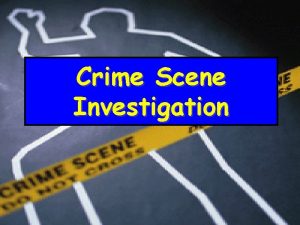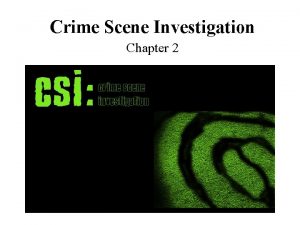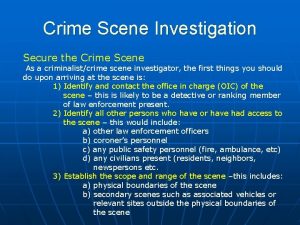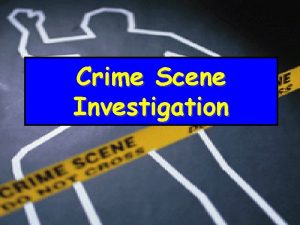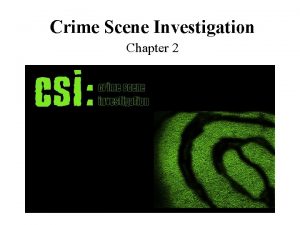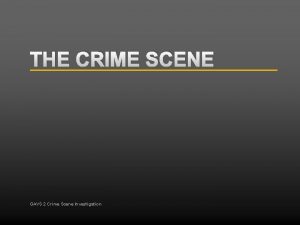CRIME SCENE INVESTIGATION Forensic Science Copyright and Terms























- Slides: 23

CRIME SCENE INVESTIGATION Forensic Science

Copyright and Terms of Service Copyright © Texas Education Agency, 2011. These materials are copyrighted © and trademarked ™ as the property of the Texas Education Agency (TEA) and may not be reproduced without the express written permission of TEA, except under the following conditions: 1) Texas public school districts, charter schools, and Education Service Centers may reproduce and use copies of the Materials and Related Materials for the districts’ and schools’ educational use without obtaining permission from TEA. 2) Residents of the state of Texas may reproduce and use copies of the Materials and Related Materials for individual personal use only, without obtaining written permission of TEA. 3) Any portion reproduced must be reproduced in its entirety and remain unedited, unaltered and unchanged in any way. 4) No monetary charge can be made for the reproduced materials or any document containing them; however, a reasonable charge to cover only the cost of reproduction and distribution may be charged. Private entities or persons located in Texas that are not Texas public school districts, Texas Education Service Centers, or Texas charter schools or any entity, whether public or private, educational or noneducational, located outside the state of Texas MUST obtain written approval from TEA and will be required to enter into a license agreement that may involve the payment of a licensing fee or a royalty. Contact TEA Copyrights with any questions you may have. Copyright © Texas Education Agency 2011. All rights reserved. Images and other multimedia content used with permission. 2

Processing a Crime Scene � Isolate and secure the scene � Document the scene � Search for evidence � � Collect and package the evidence while maintaining the chain of custody Submit the evidence for analysis Copyright © Texas Education Agency 2011. All rights reserved. Images and other multimedia content used with permission. 3

First Officer on the Scene A – Assess the crime scene and assist the injured D – Detain the witness(es) A – Arrest the perpetrator P – Protect the crime scene T – Take notes Copyright © Texas Education Agency 2011. All rights reserved. Images and other multimedia content used with permission. 4

Secure the Crime Scene 1) 2) 3) Look for signs of life Cordon off the scene (only allow authorized personnel in) Bodies should be certified as “dead” by a medical examiner (ME) before being moved Copyright © Texas Education Agency 2011. All rights reserved. Images and other multimedia content used with permission. 5

Survey the Crime Scene � � � A walkthrough is performed by the crime scene investigator, the first officer, and sometimes the lead detective Record initial observations of who, what, where, when, and how Make a plan of action Copyright © Texas Education Agency 2011. All rights reserved. Images and other multimedia content used with permission. 6

Document the Crime Scene � Record the crime scene and potential evidence with �Notes �Photography �Sketches �Videography Copyright © Texas Education Agency 2011. All rights reserved. Images and other multimedia content used with permission. 7

Notes � Record the following while at the crime scene (details are the key): � Date � Time � Description of the location, weather, and environmental conditions � Description of the crime � Location of the evidence relative to other key points � Names of all people involved � Any other relevant information Copyright © Texas Education Agency 2011. All rights reserved. Images and other multimedia content used with permission. 8

Photography � � � Nothing should be moved until photographed Take photos of the scene and the surroundings Photograph entrances and exits Take wide and close-up photos Use various angles for each piece of evidence Use a ruler to show size Copyright © Texas Education Agency 2011. All rights reserved. Images and other multimedia content used with permission. 9

Videography � � � Narrate the video Be objective Record from different perspectives Copyright © Texas Education Agency 2011. All rights reserved. Images and other multimedia content used with permission. 10

Sketches � � Draw a rough sketch at the scene (reconstruct it better later) Include �Date, time, and location �Scale �Recovered items �Important features �Accurate distance measurements of objects (from two fixed points) �A legend for description of items �A compass designating north �Names of investigators, victims, and suspects Copyright © Texas Education Agency 2011. All rights reserved. Images and other multimedia content used with permission. 11

Example: Rough Sketch Include 2 lines to show distance from evidence to a reference point, such as the wall Copyright © Texas Education Agency 2011. All rights reserved. Images and other multimedia content used with permission. 12

Search the Crime Scene � When searching a crime scene, wear the following, if available, to minimize contamination � Disposable gloves � Masks � Coveralls with a hood � Slippers Copyright © Texas Education Agency 2011. All rights reserved. Images and other multimedia content used with permission. 13

Search Patterns � � � Depend on the size and the location of the crime scene and the number of investigators available Stick to one pattern and one supervisor Better to collect everything and not need it than fail to collect something and need it later Copyright © Texas Education Agency 2011. All rights reserved. Images and other multimedia content used with permission. 14

Search Patterns (continued) � � Spiral – may move inward or outward; best used where there are no physical barriers Grid – basically a double-line search; effective, but time-consuming Line (Strip) – best in large, outdoor scenes Zone (Quadrant) – most effective in houses or buildings; teams are assigned small zones for searching Copyright © Texas Education Agency 2011. All rights reserved. Images and other multimedia content used with permission. 15

Search Patterns (continued) Spiral Strip or Line Grid Quadrant or Zone Copyright © Texas Education Agency 2011. All rights reserved. Images and other multimedia content used with permission. 16

Collect & Package Evidence � � � Physical evidence must be packaged and collected before time and weather can alter it Physical evidence – any object that can establish that a crime has been committed or links a crime and the victim or suspect The Golden Hour – the window of opportunity to collect time-sensitive information or evidence Copyright © Texas Education Agency 2011. All rights reserved. Images and other multimedia content used with permission. 17

Collect & Package Evidence (continued) � � Each item must be placed in a separate container, and sealed and labeled The most fragile evidence is collected and packaged first � Different types of evidence require specific or special collection and packaging techniques � The body is the property of the coroner or medical examiner; collection of evidence on the body is done by that department Copyright © Texas Education Agency 2011. All rights reserved. Images and other multimedia content used with permission. 18

Collect & Package Evidence (continued) � � � Containers such as vials, envelopes, plastic bags, paper bags, canisters, and cardboard boxes are good packaging devices Most items should be placed in a primary container and then in a secondary container Trace evidence may be placed on a piece of paper which is then folded in a “druggist fold” and placed in a secondary container Copyright © Texas Education Agency 2011. All rights reserved. Images and other multimedia content used with permission. 19

Collect & Package Evidence (continued) � � Containers should be sealed with tamper proof tape, and dated and initialed Each package should contain � Description of contents � Date, time, and location � Agency and collector’s name � Case number � Victim’s name(s) � Never package two items from two different sources or locations Copyright © Texas Education Agency 2011. All rights reserved. Images and other multimedia content used with permission. 20

Chain of Custody � � � There must be a written record of all people who have had possession of an item of evidence, beginning at the time of collection Every person who handled or examined the evidence must be accounted for Chain of Custody should include � Date and time of transfer � Location of transfer � To/From names � Purpose of the transfer Copyright © Texas Education Agency 2011. All rights reserved. Images and other multimedia content used with permission. 21

National Databases � � Crime Scene Investigators can submit evidence for analysis to several national databases based on the type of evidence Examples include � Automated Fingerprint Identification System (AFIS) AFIS � Integrated Automated Fingerprint Identification System (IAFIS) IAFIS � Combined DNA Index System (CODIS) CODIS � Integrated Ballistics Identification System (IBIS) IBIS � International Forensic Automotive Paint Data Query (PDQ) PDQ Copyright © Texas Education Agency 2011. All rights reserved. Images and other multimedia content used with permission. 22

Resources � � 0135158494, Saferstein, Richard. Forensic Science: An Introduction. New Jersey: Pearson Prentice Hall, 2008. 0757518257, Ball-Deslich, Barbara and John Funkhouser. Forensic Science for High School. 2 nd Edition. Kenall/Hunt, 2009. Copyright © Texas Education Agency 2011. All rights reserved. Images and other multimedia content used with permission. 23
 Forensic science begins
Forensic science begins Locard exchange principle
Locard exchange principle Seven s's of crime scene investigation
Seven s's of crime scene investigation 2106 crime scene investigation
2106 crime scene investigation Intermediate crime scene investigation #2106
Intermediate crime scene investigation #2106 Crime scene investigation vocabulary
Crime scene investigation vocabulary Crime scene vocabulary
Crime scene vocabulary 2106 crime scene investigation
2106 crime scene investigation Corpus delicti
Corpus delicti Crime scene investigation background
Crime scene investigation background What are the 5 steps in crime scene investigation
What are the 5 steps in crime scene investigation Subdatum points
Subdatum points Intermediate crime scene investigation texas
Intermediate crime scene investigation texas Crime scene note taking
Crime scene note taking Quadrant search pattern
Quadrant search pattern Disadvantages of elevation sketches
Disadvantages of elevation sketches Forensic science foodborne outbreak investigation answers
Forensic science foodborne outbreak investigation answers Forensic anthropologist vs forensic pathologist
Forensic anthropologist vs forensic pathologist Who is this
Who is this Historical scene investigation
Historical scene investigation History scene investigation
History scene investigation Crime scene factoring and quadratic functions answer key
Crime scene factoring and quadratic functions answer key Crime scene factoring and quadratic functions answer key
Crime scene factoring and quadratic functions answer key Polynomial classification
Polynomial classification
